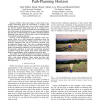Free Online Productivity Tools
i2Speak
i2Symbol
i2OCR
iTex2Img
iWeb2Print
iWeb2Shot
i2Type
iPdf2Split
iPdf2Merge
i2Bopomofo
i2Arabic
i2Style
i2Image
i2PDF
iLatex2Rtf
Sci2ools
IROS
2006
IEEE
2006
IEEE
Opportunistic Use of Vision to Push Back the Path-Planning Horizon
Abstract— Mobile robots need maps or other forms of geometric information about the environment to navigate. The mobility sensors (LADAR, stereo, etc.) on these robotic vehicles can however populate these maps only up to a distance of a few tens of meters. A navigation system has no knowledge about the world beyond this sensing horizon. As a result, path planners that rely only on this knowledge are unable to anticipate obstacles sufficiently early and have no choice but to resort to an inefficient local obstacle avoidance behavior. However, recent developments in the computer vision community allows us to collect geometric information about the environment far beyond this sensing horizon. The coarse 3D geometric estimation that can be recovered is derived from an appearance-based model. That uses a multiple-hypothesis framework to robustly estimate scene structure from a single image and estimating confidences for each geometric label. This 3D geometric estimation is used with a ...
| Added | 12 Jun 2010 |
| Updated | 12 Jun 2010 |
| Type | Conference |
| Year | 2006 |
| Where | IROS |
| Authors | Bart C. Nabbe, Derek Hoiem, Alexei A. Efros, Martial Hebert |
Comments (0)

